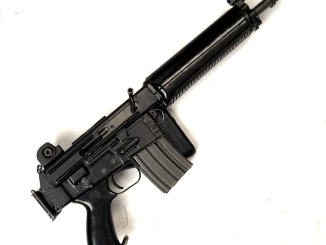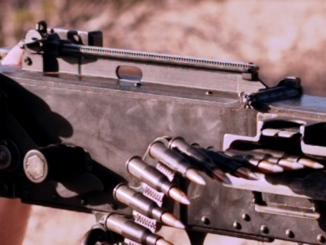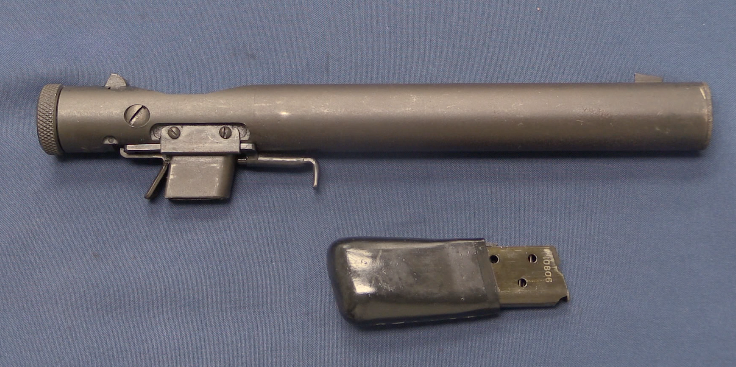Armament Research Services (ARES) is a specialist technical intelligence consultancy, offering expertise and analysis to a range of government and non-government entities in the arms and munitions field. For detailed photos of the guns in this video, don’t miss the ARES companion blog post!
By 1980, the scheduled deadline for adopting the L85 and L86 was rapidly approaching, and the weapons should have been in the last stages of fine-tuning before production began. This was not the case, however – testing was still uncovering critical problems in the guns.
The goal for these weapons was 8000 MRBF (Mean Rounds Between Failure) for the LSW and 2500 MRBF for the IW. As real testing began, the numbers were actually 100-300 MRBF. In many cases, the guns could not run three magazines in a row without a malfunction, and this was literally an order of magnitude below the requirements. But what truly led to the massive problems with the L85/86 was that RSAF Enfield did not fix these problems. Instead, they moved the goalposts. With so many problems, it was decided to only count malfunctions that occurred in the endurance testing (ie, when the guns were not put under any environmental stress at all) and to only could “critical” malfunctions in the tally. A “critical” failure was one which could not be resolved by the shooter, such as a split barrel. Simple feed or ejection failures were not counted, nor were malfunctions that required gun disassembly to correct. Even under this new paradigm, MRBF over 3000 could not be achieved.
In addition, the LSW was showing a problem that would become endemic; split groups. The weapon shot very good groups in semiautomatic, but in full auto fire it would produce two discreet groups. The first shot in each burst would land about 6 minutes of angle low and right compared to the remaining rounds in the group. This would be the subject of significant work, and was never fully rectified.




When developing the M14 the US Army “moved the goal posts” too. When competition to the M14 threatened the program (the FN FAL, the AR-15) the competing rifles were held to the “higher” standards–and quite possibly sabotaged during testing.
It’s one of the Home Court advantages–bend the rules for the home team!
A self-defeating home court advantage. The Army set itself up for total failure in future infantry vs. infantry skirmishes from that point onwards. Had the M16 been issued with PROPER ammunition, a good cleaning kit, and the original chromed barrel, people would not erroneously call it a piece of fancy plastic crap. Moving the goal posts is exactly what costs more lives. The more you want to have your way in developing weapons “according to the pride of the establishment,” the more you will PAY IN FUNERAL SERVICES.
Similarly, the US Navy during WWII refused to believe that Imperial Japan had developed a ship-launched torpedo that could snipe an aircraft carrier from 40 km away (something that the Mark 14 torpedo would fail to do, considering its unreliable detonation fuse and faulty guidance system). The Japanese had done TONS of live fire tests using actual purpose-built target ships to perfect the Type 93 torpedo’s fuse. And before anyone tells me I’m an idiot, yes, some Japanese destroyers DID HAVE ARMORED TORPEDO TURRETS (armor plating sheltered the operators from shell splinters).
See the URL below. I can tell that’s not a canvas covering, and that this is NOT a post-surrender photo (IJN flag visible, something probably NOT acceptable if US Navy in charge).
http://www.combinedfleet.com/torpmt07.jpg
Sabotaging the competition, in order to have the state sector project look better than it really is, seems to have been standard practice in united state ordnance in the twentieth century.
Examples from the very beginning of that century include the blaming of the foreign, krag and Jorgensen for the high cost of the wars with the Spanish empire. Charger feeding devices for the krag were largely ignored, the action and it’s cartridge were dismissed as “weak” (the cartridge was actually over pressure and the materials and heat treatment were the same as the low number Springfield, which may go some way to explaining those accusations). The political decision had been made to favour an indiginous crossbreed between a krag and Jorgensen and an 1893 mauser – it seems that nothing was allowed to stand in the way of that project.
More recent examples include;
the last minute switch to a heavier grenade in order to blow up the EM2 during testing in the united state. The British state didn’t use rifle grenades, the only reason there was a grenade launcher fitted, was to appeal to the united state…
Also the dirty tricks, such as a loosened front sight, discovered by Stoner, in testing of the AR15.
Military is a wing of the political. Perhaps it is too much to expect any sort of intellectual integrity at any stage.
almost painful to hear the story. how incompetent and arrogant can you be to mess up the design and production of a rifle?
“how incompetent and arrogant can you be to mess up the design and production of a rifle?”
In Soviet Union fire-arms technology, there was probably only one big-scale total flop: DS-39 machine gun, probably adopted due to influence of Stalin.
Good practice is to have multiple competitors – this was most often case in Soviet Union, where if need of new weapons system competition (конкурс) started, which should lead to choice of best, but sometimes not objective factors decided, though, so far I know, never fire-arm being fail was adopted after DS-39. It is also possible that none proposition will be adopted.
After winner is chosen, others most often fall into oblivion. For example do you know that challengers from Конкурс “Модерн”, which result in choice of AKS-74U
http://raigap.livejournal.com/84968.html
?
Writing shortly: in rifle development there should be always back-up option, if that primary fail (also true for piston-powered aeroplanes)
@ Daweo,
The contrast between the economic world views which the regimes of the cold war expressed in their propaganda:
Monopoly central planning, Vs, anarchy of production
And the practice in small arms development and procurement, which history reveals. Is always good for an ironic chuckle
In the war to make a world safe for Lenin and Trotsky, Mussolini, the house of Said, Hitler… The individuals who tried to plan aircraft development within the british state had pinned their plans for combat aircraft on the ABC Dragonfly, a static radial engine. To say that it was a dismal failure, would be a huge understatement.
Yet somehow central planning is still portrayed in the mainstream as somehow being more rational.
a smart strategy, until your home team gets killed because of you.
Hi,
The story of those rifles is a pure scandal.
Great research on the cumulative bungling that occurred.
Redefining the reliability test – bad faith tantamount to outright fraud.
Total lack accountability and total lack of any sense of responsibility.
Hide the flop and cost escalation by using cheaper materials.
Finally compounded by forcing an unreliable, non serviceable rifle in the hands of troops engaged in actual combat.
Designed by incompetents, made worse by politicians concerned with loss of face and costs, finally issued to the hapless troops who had no say in it.
The foul smell of the meddling with the M-16 procurement but made even worse by persistent bad faith.
Hi, Thanks for the presentation/history
I wonder if the 1982 Falklands war had any influence on the pressure to adopt a 5.56mm assault rifle as soon as possible, even with a lot of flaws.
During the Falklands, the British had fire volume problems with their L2A3 SMG and their Semi-Auto L1A1 SLR: Argentinians had Full-Auto FAL.
Best regards.
“Argentinians had Full-Auto FAL.”
Can’t British workshop rework L1A1 into selective-fire weapon? At least as stop-gap solution.
“adopt a 5.56mm assault rifle as soon as possible, even with a lot of flaws.”
Then they should bring existing design, optionally improving it, I am thinking about something like FFV Ak 5.
I don’t know if it was possible to rework the L1A1 into selective-fire.
However the mid- and end-1980s saw a rush from western country to adopt a 5.56mm assault rifle.
Before 1983, only the US (1967), Israel (1975), Austria (1978) and France (1979), Belgium (1983) had an assault rifle as standard weapon.
Each western country took a lot of time in the 1970s to work on a home-made “perfect” assault rife. At the end of the 1970s, ww2 era weapon stock was replaced by AK47 in the whole third world. Hence a rush to have a select-fire 5.56mm rifle for Nato countries. It didn’t end well for the UK.
As an exemple of this rush, the French forces, by mid-1978, gave up their MAS 49-56 and MAT 49, for operations in Chad and Lebanon. They replaced them with SIG 540, despite some relability issues. The Swiss army had previously rejected the SIG 540, calling it an unfinished product.
Best regards
Full auto FAL would not work, at least not with such reliability and endurance as is common with 5.56/ 5.45 rifles. Canadian FN C2 which was fully automatic support weapon with heavy barrel, was capable of carrying on only up to point of sudden cook-off.
Second and more important is lack of ability to maintain point of aim with 7.62×51 rifle; frankly out of question. I have some limited experience with 7.62×39 and even that is a real challenge.
“Talented engineers” – not quite what my reliable sources state. Apparently the way to get onto design teams at Enfield was to be promoted from the drawing office. So instead of graduate or experienced engineers, you’ve got failed art students who’ve spent 10+ years drawing gun bits tasked with designing a rifle. And of course hilarity ensued.
It’s amazing, Great Britain, the country who produced so many outstanding military weapons.
An article about The Sorry Saga of the British Bulldog’s Bullpup
http://www.historyofwar.org/articles/weapons_SA80.html
“Sorry Saga of the British Bulldog’s Bullpup”
I am wondering what would happen if Enfield EM-2 would go into wide service: http://modernfirearms.net/assault/brit/enfield-em-2-e.html
Anyway it is even more Sorry if you consider that Great Britain might have working bull-pup years earlier.
The EM2 was an expensive gun to make,
for a given investment, you don’t get as many guns or get them as quickly as you would with a gun which takes less machine time and operations.
Although small arms account for only a small percentage of battlefield and war casualties, men with guns and their boots on the ground are still necessary to hold territory, so shortage of guns would limit the ability to hold ground, and raise the cost of holding ground.
There’s a point at which lots of crappy guns will outweigh having a few excellent guns
You see something of that sort with the united state meat, with its 120 something machining operations on the receiver, and umpteen different modified models and marks, as multiple tastes were catered for.
By the time of the wars with the Spanish empire, there were only enough krags made to equip the very small regular army, all of the other forces were still equipped with trapdoor springfields. That thankfully seemed to limit Roosevelt the elder’s Imperial project.
Again, similar can be seen with the Axis in the war to make a world safe for Stalin, Mao, Pol Pot, ceacescu etc, and the time taken to source sufficient guns to equip the drastically expanded and overstretched front line units.
The MG42 was faster to make than the 34, but k98, P08 and P38 were all slow and required a lot of machine and human time to make.
Damned auto correct
It changed Krag to meat!
XL70E3 – http://i.imgur.com/L9ZdXlW.png
XL73E2 – http://i.imgur.com/jw3yNbq.png
Extremely well researched and put forth presentation on all relevant details. Thank you!
Regarding future British service rifle I feel, after state invested so much into this development, to continue in same direction with some modernization/ updates such as synthetic based receiver, modular sighting system and such; perhaps even quick change barrel. I realize that former agency who were doing the work is not there, but external firm can be hired to do that.
What comes to my mind as an immediate comparison (although about 10 years newer) is Chinese QBZ95 rifle. I had recently opportunity to shoot and in-detail examine the civilian version T97. While not being quite as perfect at the time when its development was completed, it is a decent rifle with wide application of synthetic materials and novel features. Perhaps British should take a notice for future consideration.
Also, FW featured couple years back SAR21 by Singapore Kinetics. This has exactly what it takes: clever combination of plastic and metal with unique functional features.
One has to wonder, why industrialized nations of West have difficulty to match Far East.
https://www.youtube.com/watch?v=-VCOjoY-ruU
IIRC, Sullivan spent some time workng in Singapore.